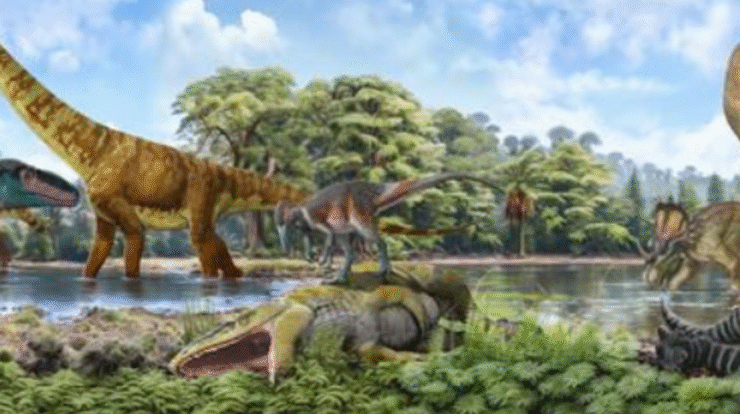
Tyrannosaurus rex, the iconic apex predator of the Late Cretaceous period, evolved in North America after its direct ancestors crossed a land bridge from Asia more than 70 million years ago, according to a new study led by researchers at University College London (UCL). The findings shed light on the long-standing debate among paleontologists regarding the geographic origins of T. rex.
“The geographic origin of T. rex is the subject of fierce debate. Paleontologists have been divided over whether its ancestor came from Asia or North America,” said Cassius Morrison, a PhD student at UCL Earth Sciences and the lead author of the study, as reported in
Live Science
.
The researchers employed mathematical models that included fossils, the lineage of dinosaurs, as well as the geographical and climatic conditions of their era to track the migrations and development of tyrannosaurs.
“Our modeling suggests the ‘grandparents’ of T. rex likely came to North America from Asia, crossing the Bering Strait between what is now Siberia and Alaska,” Morrison added.
Once in North America, T. rex evolved and became widely distributed across Laramidia, the western half of the continent during the Late Cretaceous period. Most T. rex fossils have been discovered in the U.S. states of Montana and South Dakota, as well as in Alberta, Canada. The species lived between 67 to 66 million years ago, reaching immense sizes of up to 12.5 feet tall at the hips and up to 41 feet long, weighing as much as nine tonnes.
“Our research has illuminated the appearance of the biggest tyrannosaurs in North and South America throughout the Cretaceous period and the reasons behind their rapid growth leading up to the extinction of the dinosaurs,” explained co-author Charlie Scherer, who holds an MSci degree in Earth Sciences from UCL and will be pursuing his PhD there shortly.
The study also modeled how tyrannosaurids—the group that included T. rex—and their cousins the megaraptors grew to gargantuan sizes. Both groups experienced rapid increases in size coinciding with a cooling of the global climate following a peak in temperatures 92 million years ago, known as the Cretaceous Thermal Maximum (CTM). During the CTM, sea surface temperatures in some tropical regions may have reached 95 degrees Fahrenheit (35 degrees Celsius) due to a spike in atmospheric CO₂ and methane from volcanic and tectonic activity.
After the CTM, atmospheric greenhouse gas levels and global temperatures fell, creating a cooler climate. The researchers suggested that tyrannosaurs, both tyrannosaurids and megaraptors, may have been able to better exploit these cooler temperatures than rival dinosaur groups. “This extinction likely removed the ecological barrier that prevented tyrannosaurs from growing to such sizes,” Scherer added.
A closely related group of sizable carnivorous dinosaurs known as megaraptors also underwent swift enlargement, developing into creatures approximately 33 feet long contemporaneously with tyrannosaurids. These megaraptors remain among the least understood large theropods due to the scarcity of fossil records available. They developed sleek skulls along with forelimbs that could match human height, equipped with formidable claws measuring up to 35 centimeters (14 inches).
“At the beginning of their evolutionary history, around 120 million years ago, megaraptors were part of a widespread and diverse dinosaur fauna,” said co-author Dr. Mauro Aranciaga Rolando from the Bernardino Rivadavia Natural Sciences Argentine Museum in Buenos Aires, Argentina. “While in regions like Asia megaraptors were eventually replaced by tyrannosaurs, in areas such as Australia and Patagonia they evolved to become apex predators, dominating their ecosystems,” added Aranciaga Rolando.
The study concluded that megaraptors were more widely distributed across the globe than previously thought, spreading throughout the large southern landmass of Gondwana, including present-day Africa, South America, and Antarctica. This suggests that megaraptors lived in parts of the world where no megaraptor fossils have been found so far.
The researchers suggested that both tyrannosaurids and megaraptors adapted uniquely to suit their surroundings. Unlike their tyrannosaurid relatives, which likely relied on strong bites, megaraptors possibly evolved sharp killing claws as key hunting tools. Their superior ability to thrive in colder conditions could be attributed to features such as feather insulation or a more warm-blooded metabolic system.
“Being large became more manageable when temperatures dropped. These dinosaur monarchs didn’t inevitably dominate; they benefited from environmental conditions,” stated Steve Brusatte, a paleontologist at the University of Edinburgh who wasn’t part of this research, as reported by Live Science.
The study, featured in Royal Society Open Science, offers fresh perspectives on the movement and evolution of tyrannosaurs across continents, transforming them into formidable apex predators during their era. This collaborative effort was carried out by an international group of scientists hailing from various institutions such as Oxford University, the University of Pittsburgh, the University of Aberdeen, the University of Arizona, Anglia Ruskin University, Oklahoma University, and the University of Wyoming.
The piece was composed with help from a news analysis tool.






